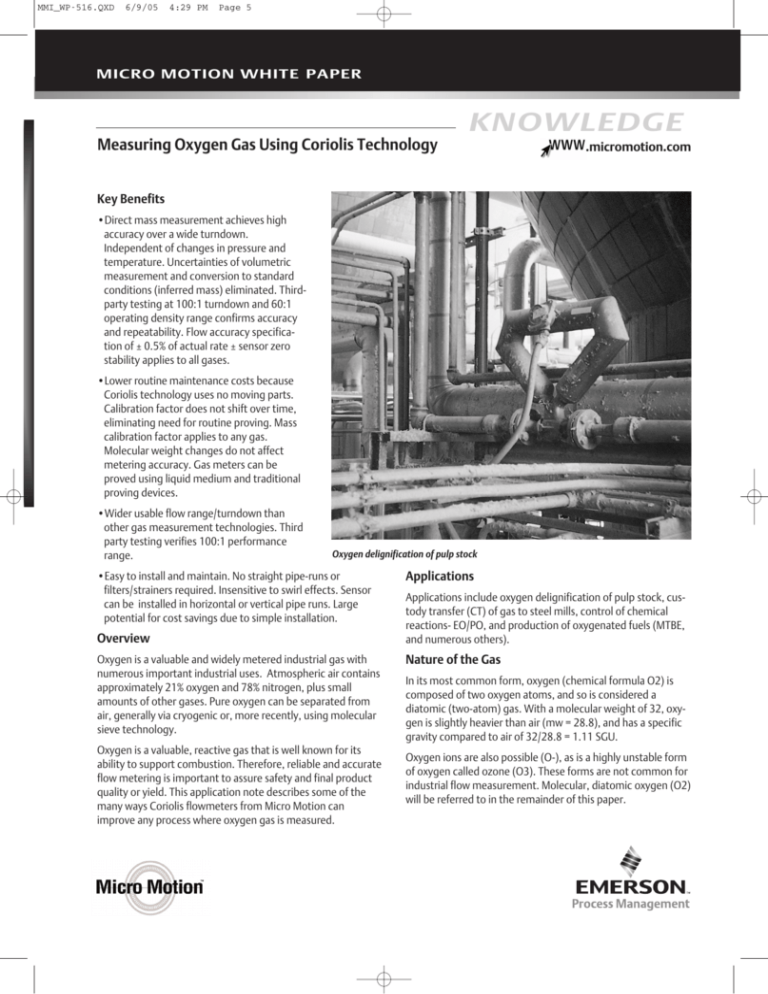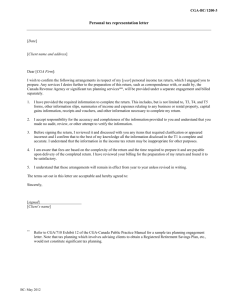
MMI_WP-516.QXD
6/9/05
4:29 PM
Page 5
MICRO MOTION WHITE PAPER
Measuring Oxygen Gas Using Coriolis Technology
KNOWLEDGE
.micromotion.com
Key Benefits
•Direct mass measurement achieves high
accuracy over a wide turndown.
Independent of changes in pressure and
temperature. Uncertainties of volumetric
measurement and conversion to standard
conditions (inferred mass) eliminated. Thirdparty testing at 100:1 turndown and 60:1
operating density range confirms accuracy
and repeatability. Flow accuracy specification of ± 0.5% of actual rate ± sensor zero
stability applies to all gases.
•Lower routine maintenance costs because
Coriolis technology uses no moving parts.
Calibration factor does not shift over time,
eliminating need for routine proving. Mass
calibration factor applies to any gas.
Molecular weight changes do not affect
metering accuracy. Gas meters can be
proved using liquid medium and traditional
proving devices.
•Wider usable flow range/turndown than
other gas measurement technologies. Third
party testing verifies 100:1 performance
range.
Oxygen delignification of pulp stock
•Easy to install and maintain. No straight pipe-runs or
filters/strainers required. Insensitive to swirl effects. Sensor
can be installed in horizontal or vertical pipe runs. Large
potential for cost savings due to simple installation.
Overview
Oxygen is a valuable and widely metered industrial gas with
numerous important industrial uses. Atmospheric air contains
approximately 21% oxygen and 78% nitrogen, plus small
amounts of other gases. Pure oxygen can be separated from
air, generally via cryogenic or, more recently, using molecular
sieve technology.
Oxygen is a valuable, reactive gas that is well known for its
ability to support combustion. Therefore, reliable and accurate
flow metering is important to assure safety and final product
quality or yield. This application note describes some of the
many ways Coriolis flowmeters from Micro Motion can
improve any process where oxygen gas is measured.
Applications
Applications include oxygen delignification of pulp stock, custody transfer (CT) of gas to steel mills, control of chemical
reactions- EO/PO, and production of oxygenated fuels (MTBE,
and numerous others).
Nature of the Gas
In its most common form, oxygen (chemical formula O2) is
composed of two oxygen atoms, and so is considered a
diatomic (two-atom) gas. With a molecular weight of 32, oxygen is slightly heavier than air (mw = 28.8), and has a specific
gravity compared to air of 32/28.8 = 1.11 SGU.
Oxygen ions are also possible (O-), as is a highly unstable form
of oxygen called ozone (O3). These forms are not common for
industrial flow measurement. Molecular, diatomic oxygen (O2)
will be referred to in the remainder of this paper.
MMI_WP-516.QXD
6/9/05
4:29 PM
Page 2
Page 2 of 4
MICRO MOTION WHITE PAPER
Oxygen has no group classification, per the National Electric
Code (NEC). However, since oxygen supports combustion of
other substances, certain precautions are typically used in oxygen piping systems to increase safety. These precautions
include special cleaning of all piping components and velocity
guidelines. Brochure G-4.4 from the USA Compressed Gas
Association is frequently used in the design, installation, and
startup of oxygen gas piping systems. CGA brochures are voluntary guidelines reflecting current industrial practices in the
chemical, steel, petroleum, and other industries, and as such,
are designed to benefit users in the areas of safety and economic transmission and distribution of gaseous oxygen.
Selected excerpts from pamphlet G-4.4 will be referenced in
this paper, specifically as applied to Coriolis measurement of
oxygen gas. It is suggested that pamphlet G-4.4 be consulted
in its entirety for additional guidelines beyond the scope of this
paper. Micro Motion wishes to express its appreciation to the
CGA for the excerpts contained herein.
The Applications
O2 delignification of pulp stock
Exposing wood pulp to oxygen gas removes additional lignins
after the Kraft digester—without attacking the wood fibers
themselves. Since lignins adversely affect pulp brightness,
delignification effectively whitens the pulp stock. In many
processes, the pulp stock is bleached using chlorine after the
O2 delignification stage. A typical process schematic is shown
below:
Fiscal transfer of oxygen gas; air separation plant to steel mill
were cited by users as valuable attributes:
“It is a great benefit to have an in-line meter capable of measuring
mass flow of O2 directly and accurately without the need to pressure and temperature compensate.”
“We forgot where the meter was because it has worked so reliably
in the 2+ years in service.”
Custody transfer of oxygen gas
Oxygen gas is commonly used in the production of steel
throughout the world. Metering the amount of gas consumed
is a custody transfer (CT) application. Payment is based on the
totalized flowmeter reading. Pricing is usually on a mass or
standard volume (inferred mass) basis, making the Coriolis
meter ideal for this application. Oxygen is usually generated
“on-demand” by an air separation plant located on site. Flow
rate can vary widely, depending on the demand from the oxygen blast furnace and the rate of steel production. High accuracy over a wide range of flow rate, pressure, and temperature
is required for accurate CT. Coriolis meters have been
approved by national governing bodies for this fiscal transfer.
Chemical reaction control
Critical chemical reactions can be controlled using Coriolis
meters to measure the mass flow rate (standard or normal volume) of oxygen feed gas. Good examples include ethylene
oxide (EO), propylene oxide (PO), and acetaldehyde.
PFD: Oxygen delignification of pulp stock
Sizing and Selection
The objective of the overall process is to use less chlorine.
Bleaching lignins requires substantial amounts of chlorine, and
removing more of the lignins earlier in the process using oxygen is more effective and reduces the amount of chorine
required. The oxygen reactor is essentially a finely tuned secondary digester.
Sizing and selection of flowmeters for oxygen service is virtually identical to sizing other Coriolis gas meters. The two primary
criteria are acceptable pressure drop and desired accuracy
over the flow range of interest. Maximum recommended
velocity per CGA Pamphlet G-4.4 can modify the flowmeter
size selected, and cleaning is frequently considered by the end
user.
Accurate control of the oxygen feed gas using a Coriolis meter
from Micro Motion enables good process control. Direct mass
measurement as well as elimination of routine maintenance
The use of the WindowsTM-based MMI WIN sizing program
greatly facilitates sizing and selection of the oxygen gas
MMI_WP-516.QXD
6/9/05
4:29 PM
Page 3
Measuring Oxygen Gas Using Coriolis Technology
Page 3 of 4
PFD: Acetaldehyde production using oxygen process
flowmeter. User-entered variables include flow rate, operating
pressure, and temperature. Several possible flowmeter models are selected by the program. The final selection is based on
allowable pressure drop, desired accuracy, and velocity.
Micro Motion’s ELITE® flowmeter is preferred for gas service
(although numerous D-model flowmeters have been used in
the past), and are preferentially selected by the sizing program. With sizes ranging from the 1/4" (6 mm) model CMF025
to the 3" (80 mm) model CMF300, oxygen flow rates from virtually zero to approximately 7000 scfm (600 lb/min) or 12 x
106 NM3/h (16,000 kg/h) can be measured using a single
flowmeter (following the CGA velocity guidelines). For higher
flow rates, two or more CMF300 sensors can be installed in
parallel.
CGA velocity guidelines are shown in Figure 1. Per CGA, pipe
size should be selected to adhere to the maximum recommended velocity as a function of gas pressure. This is based on
typical stainless steel piping. CGA guidelines also include information on system components such as flowmeters, where
due to practical sizing concerns, the piping velocity guidelines
may be exceeded.
The CGA suggests that upstream filters be considered to
remove particulate material. This prevents impingement and
possible sparking.
Impingement of particulates (weld slag, bits of corrosion, or
rust particles) at high velocity is thought to create sparking,
and is therefore a source of ignition energy. In the presence of
combustible particulate material, this can initiate fires inside
the piping.
Oxygen service cleaning is frequently specified by the end-user
and is intended to eliminate sources of combustible material
inside the piping. When internal organic, inorganic, and particulate matter are removed, a system is generally considered
clean for oxygen service. The following excerpt from paragraph 3.5 Oxygen Service Cleaning of CGA Pamphlet G-4.4
explains further:
3.5.1 General requirements
A system is considered clean for oxygen service when internal
organic, inorganic, and particulate matter are removed. Removal
of contaminants such as greases, oils, thread lubricants, dirt,
water, filings, scale, weld spatter, paints, or other foreign material
is considered critical. This can be accomplished by precleaning all
parts and maintaining this condition during construction, by completely cleaning the system after construction, or by a combination of the two. CGA Pamphlet G-4.1 thoroughly describes this
procedure.
Oxygen service cleaning of the sensor is available from Micro
Motion for a nominal charge.
Performed by qualified outside vendors, the cleaned sensor is
then “bagged, tagged, and sealed.” Please contact the factory
or your local sales representative for more information on oxygen service cleaning.
References
User reference lists are available to help verify manufacturer
claims. Customer copies of third-party test data is also availFigure 1. CGA velocity guidelines
MMI_WP-516.QXD
6/9/05
4:29 PM
Page 4
Page 4 of 4
MICRO MOTION WHITE PAPER
Measuring Oxygen Gas Using Coriolis Technology
able. Please contact your local sales representative for more
information.
Summary
Oxygen is a commonly measured, valuable industrial gas and
is used in a wide variety of processes. Reliable, accurate flow
measurement is critical to insuring the safety of plant personnel, product quality, and maximum yield. Existing volumetric
technologies such as dP, turbine, and vortex are limited by
turndown, accuracy, and reliability. Thermal mass meters have
often been used, but are somewhat maintenance-intensive
and have the tendency to drift with ambient temperature
changes.
More recently, Coriolis meters from Micro Motion have been
used in oxygen service with excellent results. With useable
turndown of 100:1 and excellent accuracy over a 60:1 operating density range, Coriolis meters from Micro Motion also
eliminate straight-run requirements and routine maintenance.
Direct mass measurement, synonymous with standard or normal volumetric units, is fundamentally more accurate, and
eliminates the need for flow correction factors based on pressure and temperature. Installation is simple and straightforward, with no requirements for flow conditioning.
With an installed base of over 150,000 flow and density sensors worldwide, Micro Motion can provide the measurement
expertise and support you desire. Extensive third-party testing, and more than 7500 gas-phase applications around the
world, have increasingly shown the numerous benefits of
using Micro Motion Coriolis technology to measure oxygen
gas.
.micromotion.com
The contents of this publication are presented for informational purposes only and,
while every effort has been made to ensure their accuracy, they are not to be construed
as warranties or guarantees, expressed or implied, regarding the products or services
Micro Motion supports PlantWeb field-based architecture,
a scalable way to use open and interoperable devices and
systems to build process solutions of the future.
Micro Motion, Inc. USA
Worldwide Headquarters
7070 Winchester Circle
Boulder, Colorado 80301
T (303) 527-5200
(800) 522-6277
F (303) 530-8459
www.micromotion.com
WP-00516
Micro Motion Europe
Emerson Process Management
Wiltonstraat 30
3905 KW Veenendaal
The Netherlands
T +31 (0) 318 549 549
F +31 (0) 318 549 559
described herein or their use or applicability. We reserve the right to modify or improve
the designs or specifications of our products at any time without notice.
Micro Motion Japan
Emerson Process Management
Shinagawa NF Bldg. 5F
1-2-5, Higashi Shinagawa
Shinagawa-ku
Tokyo 140-0002 Japan
T (81) 3 5769-6803
F (81) 3 5769-6843
Micro Motion Asia
Emerson Process Management
1 Pandan Crescent
Singapore 128461
Republic of Singapore
T (65) 6 777-8211
F (65) 6 770-8003
©2004. Micro Motion, Inc. All rights reserved.





